2000 HONDA CIVIC COUPE ECO mode
[x] Cancel search: ECO modePage 9 of 293
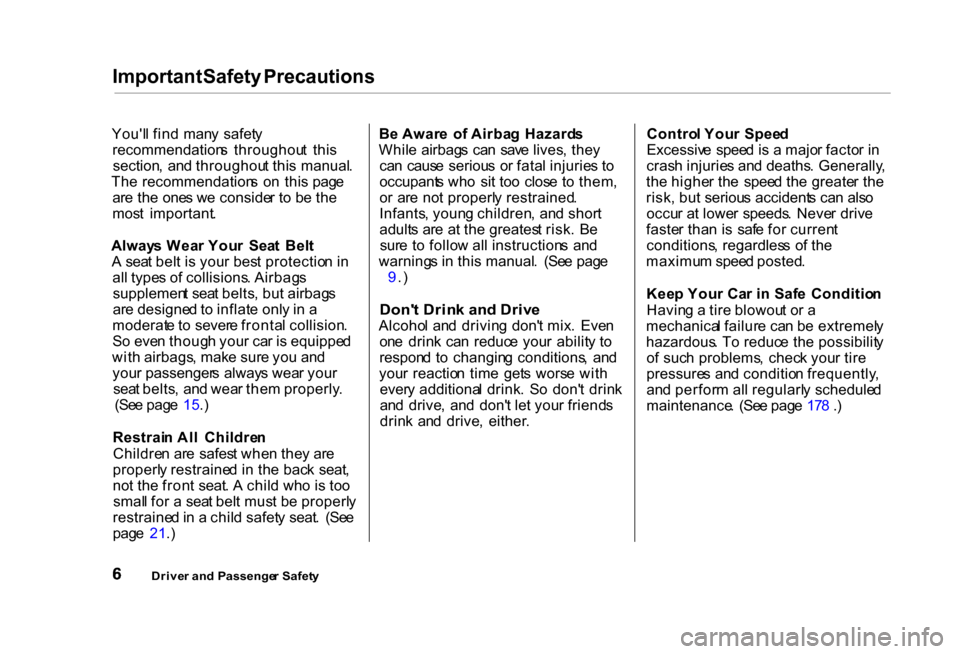
Important
Safety Precautions
You'l l fin d man y safet y
recommendation s throughou t thi s
section , an d throughou t thi s manual .
Th e recommendation s o n thi s pag e
ar e th e one s w e conside r t o b e th e
mos t important .
Alway s Wea r You r Sea t Bel t
A sea t bel t i s you r bes t protectio n i n
al l type s o f collisions . Airbag s
supplemen t sea t belts , bu t airbag s
ar e designe d t o inflat e onl y i n a
moderat e to sever e fronta l collision .
S o eve n thoug h you r ca r i s equippe d
wit h airbags , mak e sur e yo u an d
you r passenger s alway s wea r you r
sea t belts , an d wea r the m properly .
(Se e pag e 15 .)
Restrai n Al l Childre n
Childre n ar e safes t whe n the y ar e
properl y restraine d i n th e bac k seat ,
no t th e fron t seat . A chil d wh o i s to o
smal l fo r a sea t bel t mus t b e properl y
restraine d in a chil d safet y seat . (Se e
pag e 21 .) B
e Awar e o f Airba g Hazard s
Whil e airbag s ca n sav e lives , the y
ca n caus e seriou s o r fata l injurie s t o
occupant s wh o si t to o clos e t o them ,
o r ar e no t properl y restrained .
Infants , youn g children , an d shor t
adult s ar e a t th e greates t risk . B e
sur e t o follo w al l instruction s an d
warning s i n thi s manual . (Se e pag e
9 .)
Don' t Drin k an d Driv e
Alcoho l an d drivin g don' t mix . Eve n
on e drin k ca n reduc e you r abilit y t o
respon d t o changin g conditions , an d
you r reactio n tim e get s wors e wit h
ever y additiona l drink . S o don' t drin k
an d drive , an d don' t le t you r friend s
drin k an d drive , either . Contro
l You r Spee d
Excessiv e spee d is a majo r facto r i n
cras h injurie s an d deaths . Generally ,
th e highe r th e spee d th e greate r th e
risk , bu t seriou s accident s ca n als o
occu r a t lowe r speeds . Neve r driv e
faste r tha n i s saf e fo r curren t
conditions , regardles s o f th e
maximu m spee d posted .
Kee p You r Ca r i n Saf e Conditio n
Havin g a tir e blowou t o r a
mechanica l failur e ca n b e extremel y
hazardous . T o reduc e th e possibilit y
o f suc h problems , chec k you r tir e
pressure s an d conditio n frequently ,
an d perfor m al l regularl y schedule d
maintenance . (Se e pag e 17 8 .)
Drive r an d Passenge r Safet y
Page 25 of 293
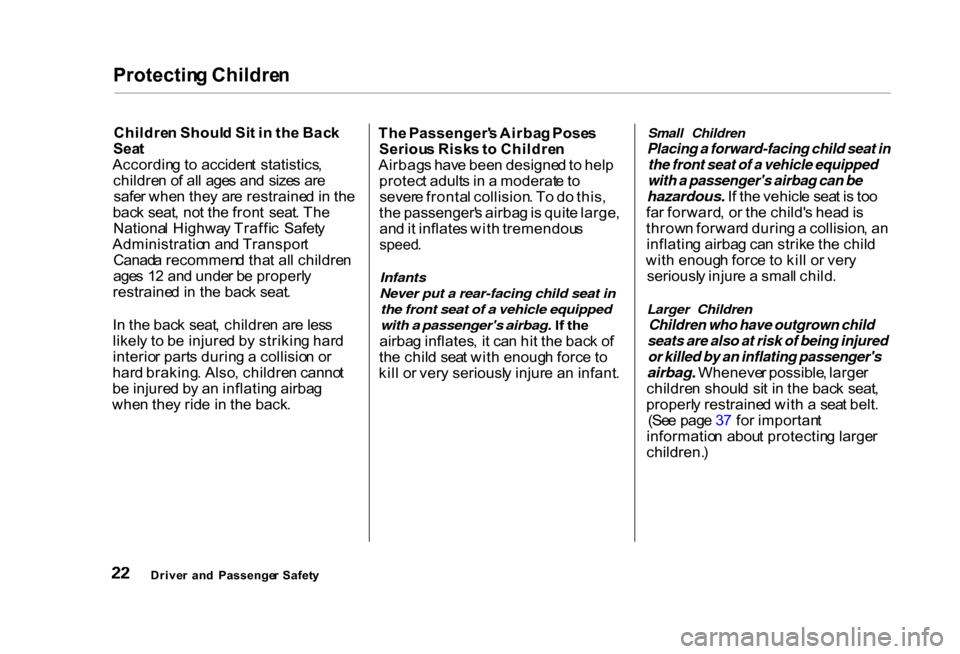
Protectin
g Childre n
Childre n Shoul d Si t i n th e Bac k
Sea t
Accordin g t o acciden t statistics ,
childre n o f al l age s an d size s ar e
safe r whe n the y ar e restraine d in th e
bac k seat , no t th e fron t seat . Th e
Nationa l Highwa y Traffi c Safet y
Administratio n an d Transpor t
Canad a recommen d tha t al l childre n
age s 1 2 an d unde r b e properl y
restraine d in th e bac k seat .
I n th e bac k seat , childre n ar e les s
likel y t o b e injure d b y strikin g har d
interio r part s durin g a collisio n o r
har d braking . Also , childre n canno t
b e injure d b y a n inflatin g airba g
whe n the y rid e in th e back . Th
e Passenger' s Airba g Pose s
Seriou s Risk s t o Childre n
Airbag s hav e bee n designe d to hel p
protec t adult s in a moderat e to
sever e fronta l collision . T o d o this ,
th e passenger' s airba g is quit e large ,
an d it inflate s wit h tremendou s
speed .
Infants
Never put a rear-facing child seat in the front seat of a vehicle equipped
with a passenger's airbag. I f th e
airba g inflates , i t ca n hi t th e bac k o f
th e chil d sea t wit h enoug h forc e t o
kil l o r ver y seriousl y injur e a n infant .Small Children
Placing a forward-facing child seat in the front seat of a vehicle equipped
with a passenger's airbag can be
hazardous. I f th e vehicl e sea t i s to o
fa r forward , o r th e child' s hea d is
throw n forwar d durin g a collision , a n
inflatin g airba g ca n strik e th e chil d
wit h enoug h forc e t o kil l o r ver y
seriousl y injur e a smal l child .
Larger Children
Children who have outgrown child
seats are also at risk of being injured or killed by an inflating passenger's
airbag. Wheneve r possible , large r
childre n shoul d si t i n th e bac k seat ,
properl y restraine d wit h a sea t belt .
(Se e pag e 3 7 fo r importan t
informatio n abou t protectin g large r
children. )
Drive r an d Passenge r Safet y
Page 29 of 293
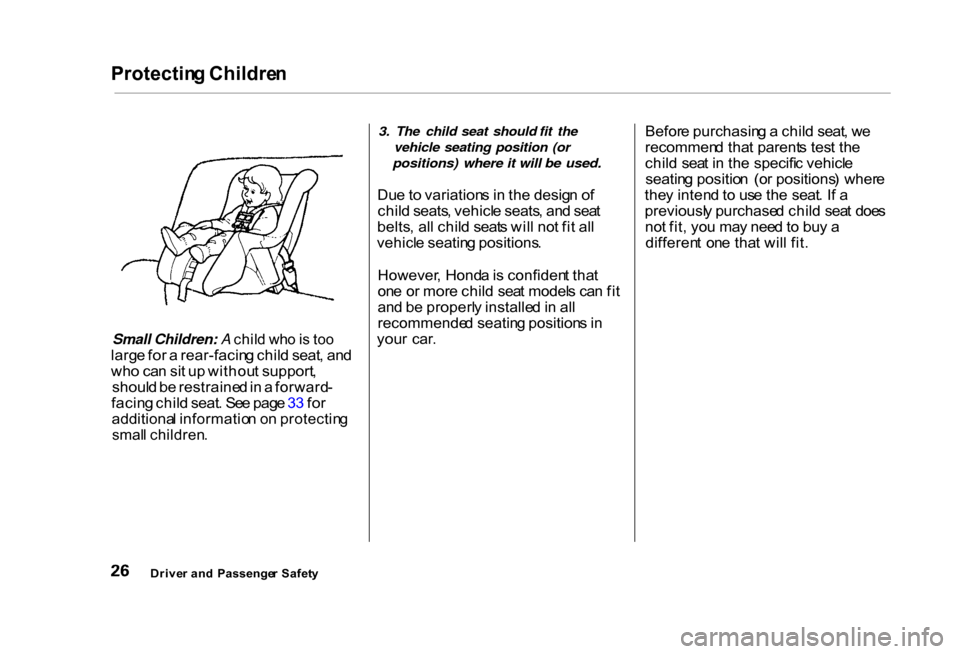
Protectin
g Childre n
Small Children: A chil d wh o is to o
larg e fo r a rear-facin g chil d seat , an d
wh o ca n si t u p withou t support ,
shoul d b e restraine d in a forward -
facin g chil d seat . Se e pag e 3 3 fo r
additiona l informatio n o n protectin g
smal l children .
3. The child seat should fit the
vehicle seating position (or
positions) where it will be used.
Du e to variation s in th e desig n o f
chil d seats , vehicl e seats , an d sea t
belts , al l chil d seat s wil l no t fi t al l
vehicl e seatin g positions .
However , Hond a is confiden t tha t
on e o r mor e chil d sea t model s ca n fi t
an d b e properl y installe d in al l
recommende d seatin g position s in
you r car . Befor
e purchasin g a chil d seat , w e
recommen d tha t parent s tes t th e
chil d sea t i n th e specifi c vehicl e
seatin g positio n (o r positions ) wher e
the y inten d to us e th e seat . I f a
previousl y purchase d chil d sea t doe s
no t fit , yo u ma y nee d to bu y a
differen t on e tha t wil l fit .
Drive r an d Passenge r Safet y
Page 32 of 293
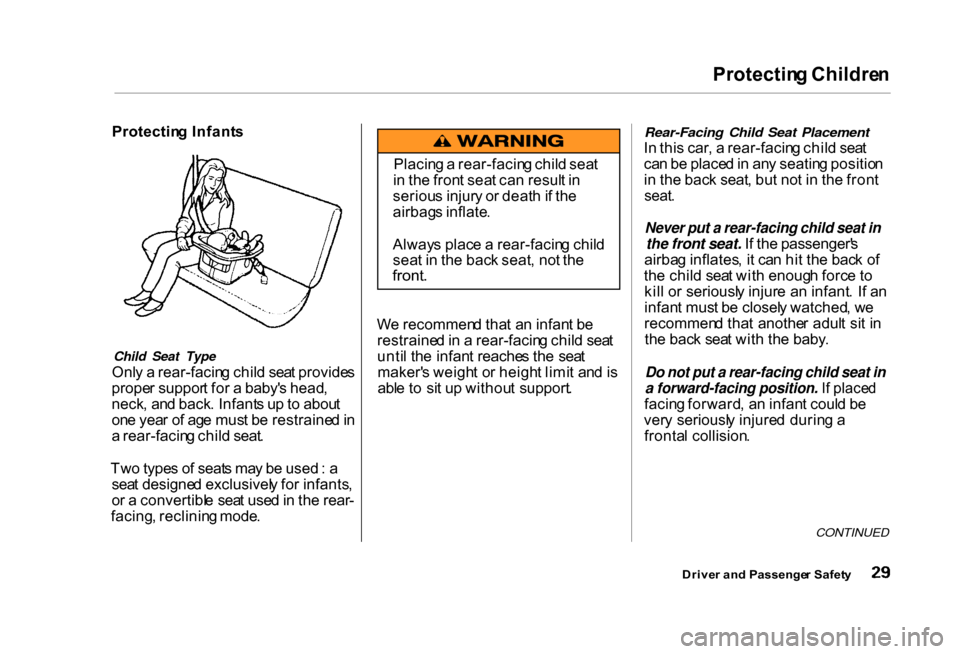
Protectin
g Childre n
Protectin g Infant s
Child Seat Type
Onl y a rear-facin g chil d sea t provide s
prope r suppor t fo r a baby' s head ,
neck , an d back . Infant s u p to abou t
on e yea r o f ag e mus t b e restraine d in
a rear-facin g chil d seat .
Tw o type s o f seat s ma y b e used : a
sea t designe d exclusivel y fo r infants ,
o r a convertibl e sea t use d in th e rear -
facing , reclinin g mode . W
e recommen d tha t a n infan t b e
restraine d in a rear-facin g chil d sea t
unti l th e infan t reache s th e sea t
maker' s weigh t o r heigh t limi t an d is
abl e t o si t u p withou t support .
Rear-Facing Child Seat Placement
I n thi s car , a rear-facin g chil d sea t
ca n b e place d in an y seatin g positio n
i n th e bac k seat , bu t no t i n th e fron t
seat .
Never put a rear-facing child seat in
the front seat. I f th e passenger' s
airba g inflates , i t ca n hi t th e bac k o f
th e chil d sea t wit h enoug h forc e t o
kil l o r seriousl y injur e a n infant . I f a n
infan t mus t b e closel y watched , w e
recommen d tha t anothe r adul t si t i n
th e bac k sea t wit h th e baby .
Do not put a rear-facing child seat in
a forward-facing position. I f place d
facin g forward , a n infan t coul d b e
ver y seriousl y injure d durin g a
fronta l collision .
CONTINUED
Drive r an d Passenge r Safet y
Placin
g a rear-facin g chil d sea t
i n th e fron t sea t ca n resul t i n
seriou s injur y o r deat h if th e
airbag s inflate .
Alway s plac e a rear-facin g chil d
sea t i n th e bac k seat , no t th e
front .
Page 53 of 293
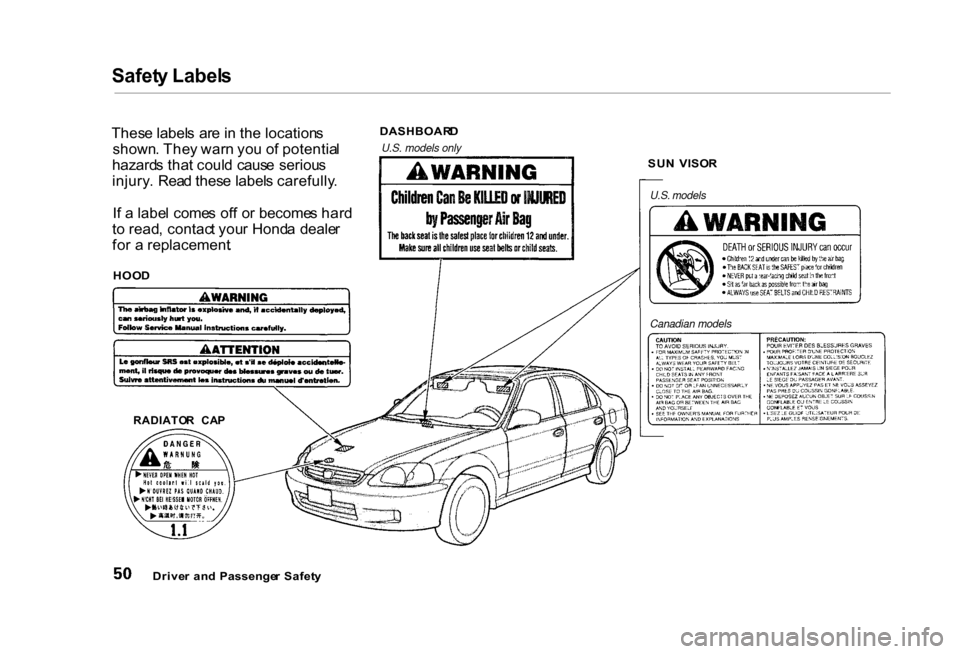
Safet
y Label s
Thes e label s ar e in th e location s
shown . The y war n yo u o f potentia l
hazard s tha t coul d caus e seriou s
injury . Rea d thes e label s carefully .
I f a labe l come s of f o r become s har d
t o read , contac t you r Hond a deale r
fo r a replacement .
DASHBOAR
D
U.S. models only
Drive r an d Passenge r Safet y
HOO
D
RADIATO R CA P
SU
N VISO R
Canadian models U.S. models
Page 57 of 293
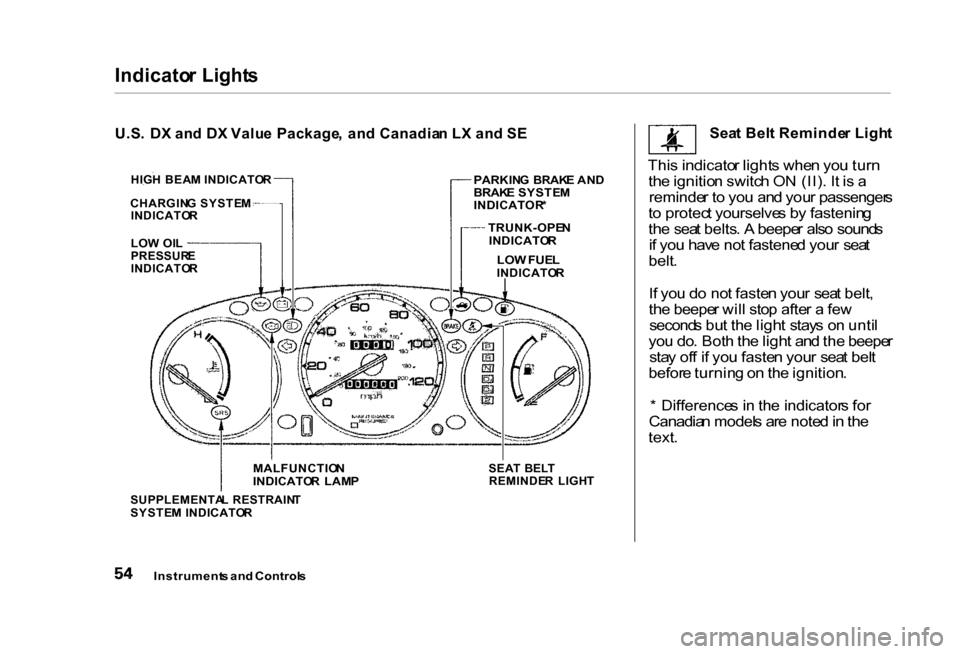
Indicato
r Light s
U.S . D X an d D X Valu e Package , an d Canadia n L X an d S E
Sea
t Bel t Reminde r Ligh t
Thi s indicato r light s whe n yo u tur n
th e ignitio n switc h O N (II) . I t i s a
reminde r t o yo u an d you r passenger s
t o protec t yourselve s b y fastenin g
th e sea t belts . A beepe r als o sound s
i f yo u hav e no t fastene d you r sea t
belt .
I f yo u d o no t faste n you r sea t belt ,
th e beepe r wil l sto p afte r a fe w
second s bu t th e ligh t stay s o n unti l
yo u do . Bot h th e ligh t an d the beepe r
sta y of f i f yo u faste n you r sea t bel t
befor e turnin g o n th e ignition .
* Difference s i n th e indicator s fo r
Canadia n model s ar e note d in th e
text .
Instrument s an d Control s
HIG
H BEA M INDICATO R
CHARGIN G SYSTE M
INDICATO R
LO W OI L
PRESSUR E
INDICATO R
SUPPLEMENTA L RESTRAIN T
SYSTE M INDICATO R
MALFUNCTIO
N
INDICATO R LAM P
SEA
T BEL T
REMINDE R LIGH T
PARKIN
G BRAK E AN D
BRAK E SYSTE M
INDICATOR *
TRUNK-OPE N
INDICATO R
LO W FUE L
INDICATO R
Page 58 of 293
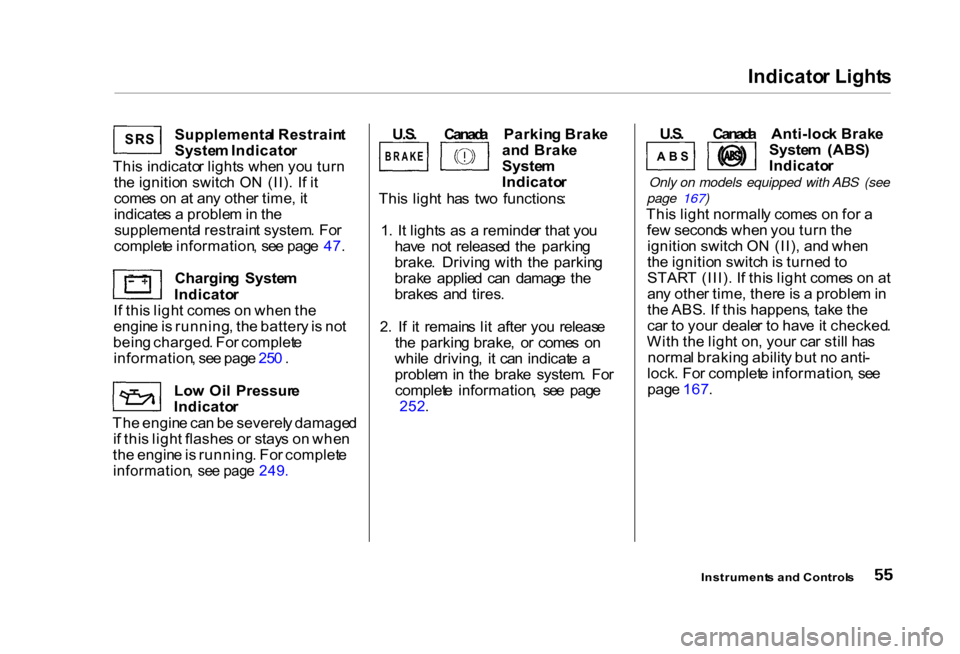
Indicato
r Light s
Supplementa l Restrain t
Syste m Indicato r
Thi s indicato r light s whe n yo u tur n
th e ignitio n switc h O N (II) . I f i t
come s o n a t an y othe r time , i t
indicate s a proble m in th e
supplementa l restrain t system . Fo r
complet e information , se e pag e 47 .
Chargin g Syste m
Indicato r
I f thi s ligh t come s o n whe n th e
engin e is running , th e batter y is no t
bein g charged . Fo r complet e
information , se e pag e 25 0 .
Lo w Oi l Pressur e
Indicato r
Th e engin e ca n b e severel y damage d
i f thi s ligh t flashe s o r stay s o n whe n
th e engin e is running . Fo r complet e
information , se e pag e 249 .
U.S
. Canad a Parkin g Brak e
an d Brak e
Syste m
Indicato r
Thi s ligh t ha s tw o functions :
1 . I t light s a s a reminde r tha t yo u
hav e no t release d th e parkin g
brake . Drivin g wit h th e parkin g
brak e applie d ca n damag e th e
brake s an d tires .
2 . I f i t remain s li t afte r yo u releas e
th e parkin g brake , o r come s o n
whil e driving , i t ca n indicat e a
proble m in th e brak e system . Fo r
complet e information , se e pag e
252 . U.S
. Canad a Anti-loc k Brak e
Syste m (ABS )
Indicato r
Only on models equipped with ABS (see
page 167)
Thi s ligh t normall y come s o n fo r a
fe w second s whe n yo u tur n th e
ignitio n switc h O N (II) , an d whe n
th e ignitio n switc h is turne d to
STAR T (III) . I f thi s ligh t come s o n a t
an y othe r time , ther e is a proble m in
th e ABS . I f thi s happens , tak e th e
ca r t o you r deale r t o hav e it checked .
Wit h th e ligh t on , you r ca r stil l ha s
norma l brakin g abilit y bu t n o anti -
lock . Fo r complet e information , se e
pag e 167 .
Instrument s an d Control s
BRAK
E
AB
S
SR
S
Page 66 of 293
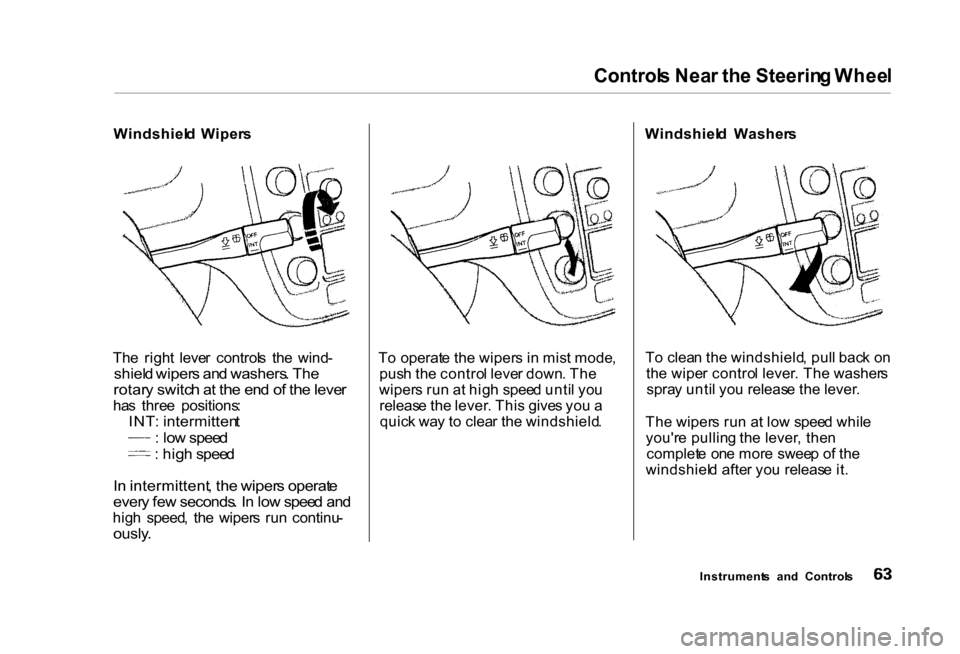
Control
s Nea r th e Steerin g Whee l
Windshiel d Wiper s
Th e righ t leve r control s th e wind -
shiel d wiper s an d washers . Th e
rotar y switc h a t th e en d o f th e leve r
ha s thre e positions :
INT : intermitten t
: lo w spee d
: hig h spee d
I n intermittent , th e wiper s operat e
ever y fe w seconds . I n lo w spee d an d
hig h speed , th e wiper s ru n continu -
ously .
T
o operat e th e wiper s i n mis t mode ,
pus h th e contro l leve r down . Th e
wiper s ru n a t hig h spee d unti l yo u
releas e th e lever . Thi s give s yo u a
quic k wa y t o clea r th e windshield .Windshiel
d Washer s
T o clea n th e windshield , pul l bac k o n
th e wipe r contro l lever . Th e washer s
spra y unti l yo u releas e th e lever .
Th e wiper s ru n a t lo w spee d whil e
you'r e pullin g th e lever , the n
complet e on e mor e swee p of th e
windshiel d afte r yo u releas e it .
Instrument s an d Control s